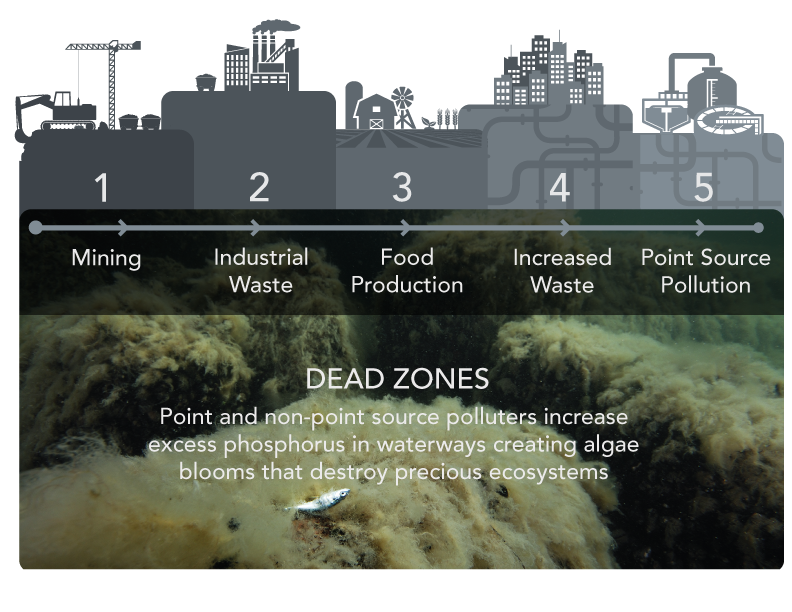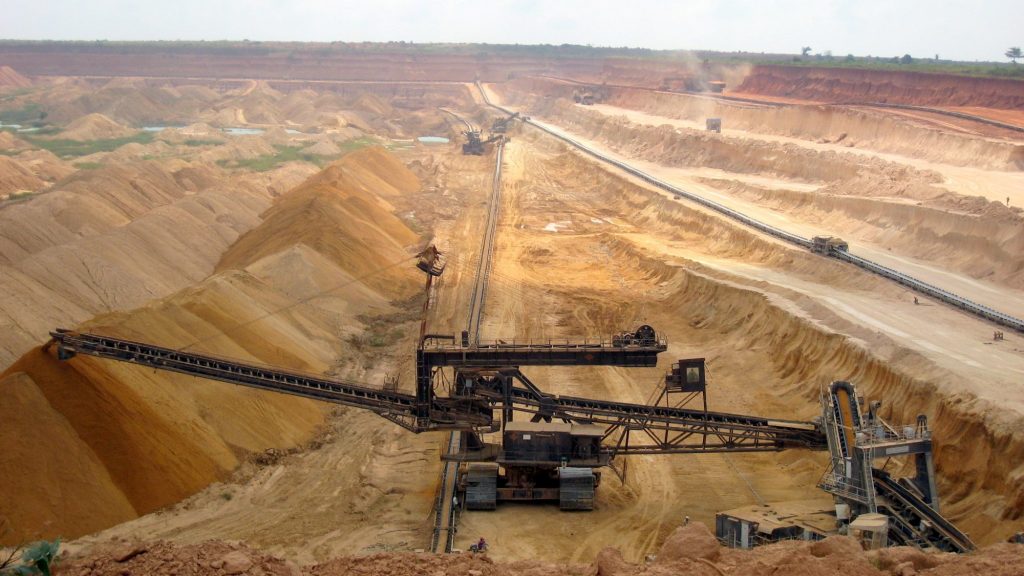Reforming a Phosphorus Cycle and the Pursuit of Sustainability
Preserving a valuable resource and the environment by recycling phosphorus
Kevin Wallington and Majid Shafiee-Jood
“We have broken the phosphorus cycle,” declared Molly Biedenfeld, Vice President of Nutrients Market Development and Sales at Ostara Nutrient Recovery Technologies Inc. In fact, as Biedenfeld described, as a result of human intervention, phosphorus processes no longer resemble a cycle at all but rather a terminal sequence. One ramification of this current, human-altered phosphorus sequence: phosphorus, traditionally managed as a nutrient in our fields, now also presents risks as a pollutant in our waters. In response to this challenge of phosphorus management, scientists and practitioners gathered for the Advancing Food–Energy–Water System Resilience Through a Regional Resource Recovery Network symposium to discuss whether we can recreate a phosphorus cycle which promotes agricultural productivity and preserves the quality of our environment.
Phosphorus is an essential nutrient for plant growth and thus critical to agricultural productivity. In a natural setting, phosphorus present in the earth’s crust is slowly made available to plants through weathering processes, as described by Andrew Margenot, Professor of Crop Sciences at the University of Illinois, in the afternoon of the symposium. Yet, not all phosphorus in soils is taken up by the plants in the field. Following rainfall, a portion of phosphorus in soils is transported by water to streams then lakes or oceans. Tectonic processes then slowly recirculate phosphorus from ocean sediments back to terrestrial bedrock, where it is again subject to weathering, completing the phosphorus cycle.
Margenot went on to explain how, by mining phosphate rock and applying it to agricultural fields as fertilizer, humans have greatly accelerated the rate at which phosphorus reaches soils and becomes available to plants. Increased phosphorus availability has enhanced crop yields and has been critical to meeting the world’s booming demand for food (and fuel, via ethanol), emphasized Andrew Sharpley, Professor of Crop, Soil, and Environmental Sciences at the University of Arkansas. However, the rate at which phosphorus is mined, applied to fields, and washed into lakes and oceans dwarfs the planet’s tectonic capacity to recirculate the phosphorus. Thus, recirculation has become negligible in the new, shortened time scale of phosphorus extraction, breaking a link in the natural phosphorus cycle, and rendering it a terminal phosphorus sequence.

At the outset of the symposium, Ximing Cai, Professor of Civil Engineering at the University of Illinois and convener of the symposium, called participants’ attention to the risks posed by high levels of phosphorus in our waters. When overdoses of phosphorus reach lakes, streams, and oceans, they promote excessive, undesirable algae or plankton growth. In 2014, half a million residents of Toledo, Ohio, were cut off from their water supply for three days due to dangerous levels of toxins released by algal blooms. In the Gulf of Mexico, elevated phosphorus levels have contributed to unprecedented phytoplankton growth. As plankton die and are decomposed, oxygen in the water is consumed, and not enough oxygen is left behind for other aquatic organisms to survive, leading to massive fish kills. Today, the “Dead Zone” at the mouth of the Mississippi River, which drains the majority of the United States’ farmland, has reached the size of the state of New Jersey. This, as Sharpley put it, is the paradox of phosphorus management: extensive application of phosphorus fertilizer is essential to achieving crop yields necessary to feed the growing global population, but when such high levels of phosphorus wash into our waters, it degrades aquatic environments and threatens human health.
To manage phosphorus in our watersheds, we must first understand what is happening with phosphorus in our watersheds, as addressed in the morning session of the symposium. To begin the session, Sharpley explained why, in the midwestern United States, efforts to rectify phosphorus pollution have largely been unsuccessful. Efforts thus far have been centered on the adoption of new best management practices by farmers. However, adoption of such practices, said Sharpley, has not been as widespread as necessary for improving our waters, and even where adopted, they have not yielded the originally expected results. As Sharpley described, soils have built up a “legacy” of phosphorus, accrued from previous fertilizer applications, which is slowly being released, delaying the achievement of water quality goals for decades. We must, in Sharpley’s words, work to get “diagnosis” and “remedy” right in order to redirect future efforts toward more effective solutions.
To properly diagnose what is happening in our watersheds and create suitable remedies, we must extend our abilities for observation and modeling. As demonstrated by Greg McIsaac, Professor Emeritus of Natural Resources and Environmental Sciences at the University of Illinois, current phosphorus monitoring practices often fail to record the largest, most important phosphorus fluxes in streams. For example, as reported by McIsaac, the primary water quality monitoring organization in Illinois, the Illinois Environmental Protection Agency (IEPA), only samples phosphorus concentrations nine times per year. In central Illinois’ Embarras Watershed, special independent sampling showed that IEPA samples missed nearly every major phosphorus discharge event since 1993. New, continuous phosphorus sampling devices could significantly improve our understanding of what is happening in watersheds. To conclude the morning session, Indrajeet Chaubey, Professor of Agricultural and Biological Engineering at Purdue University, provided a vision forward for watershed modeling, a process by which scientists create a mathematical representation of a physical watershed. Models may be used to help fill gaps in observation records and to predict outcomes of potential future scenarios but must be made more representative of physical processes and require calibration with existing data. Such data is, as mentioned by McIsaac, often insufficiently available. Improvements in monitoring and modeling, such as those explained by McIsaac and Chaubey, are essential to know where to begin remediation efforts in specific watersheds.
As the first afternoon session began, presenters laid out an additional piece of the phosphorus management challenge—the finite nature of phosphate rock which can be mined from the earth. Because phosphorus is mined at a rate beyond the planet’s capacity to replenish it, phosphorus has been transformed from a renewable to a non-renewable resource. The first afternoon session of the symposium sought to provide an overview of whether the phosphorus sequence can be effectively closed to once again form a cycle and a sustainable solution to the paradox of phosphorus management.

Recirculating phosphorus requires recovery of phosphorus at some point along its process chain and reuse of the recovered phosphorus, the two focuses of the first afternoon session. Central Illinois, said Roland Cusick, Professor of Environmental Engineering at the University of Illinois, is a prime example of where, geographically, phosphorus recovery and reuse may be feasible. The midwestern United States, being heavily fertilized agricultural land, generates high phosphorus demand. On the other hand, in Decatur, Illinois, bioethanol refineries consume midwestern corn and produce a wastewater by-product which is high in phosphorus concentration. As explained by Cusick and Akita Juneja, Postdoctoral Fellow in Agricultural and Biological Engineering at the University of Illinois, phosphorus could be recovered directly from these waste streams and applied to nearby agricultural land, creating a new phosphorus cycle which would reduce both the phosphorus discharge to streams and the need for mining new phosphorus from the earth.
While the first two sessions of the symposium paid more attention to the scientific aspects of the phosphorus cycle and management, the last session primarily focused on implementation of the scientific research and the proposed solution. The purpose of the session was, as put by the moderator, Steve John, Co-Founder and Executive Director at Agricultural Watershed Institute, to challenge ourselves to think about how interdisciplinary science can lead to positive changes in the agricultural landscape, in agricultural industry, and in water and wastewater utilities. This resonated well with the main theme of the Illinois 150 conference: What does it mean for the research to serve the public good?
Successful implementation of the research requires stakeholder engagement. One key reason to engage stakeholders is to maximize the impact and relevance of the research. In fact, as put by Ben Gramig, Professor of Agricultural and Consumer Economics at the University of Illinois, “Stakeholder engagement is a necessary condition for success.” Here, Gramig emphasized, success is defined as generating usable science: science which is usable by and useful to decision-makers and stakeholders. Scientists need to engage stakeholders early in order to better understand the problems before prescribing solutions and identifying barriers to implementation. It is equally important to follow up with stakeholders and re-engage them during the research to get feedback and refine the research.
One of the key issues in research implementation, which also arises in engaging with stakeholders, is the tremendous amount of uncertainty involved in natural, physical, and socio-economic systems. For instance, while phosphorus recovery is technologically feasible, the usefulness of recovered phosphorus, as opposed to natural phosphorus, is unknown. This is in part due to the uncertainty in yield performance of the crops fertilized by recovered phosphorus. Different forms of fertilizer are more or less suitable for different crops and soils, depending on multiple biogeochemical factors described by Margenot, and struvite, the form typically recovered from waste streams, has not been tested to verify yield performance for many types. On the other hand, even where struvite’s performance is known for a given combination of crop and soil, farmers are often resistant to trying an unfamiliar product, said Biedenfeld. Farmers have a long history with their existing fertilizer practices and high demands for return on investment, which have inhibited their acceptance of emerging fertilizer technology. Some of these issues possibly could be resolved through stakeholder engagement, but a critical question is how to engage stakeholders given that scientists themselves cannot anticipate the future outcomes of adopting the proposed practices. Gramig proposed that one way to approach this problem is to properly communicate the uncertainties involved and explain potential consequences to the stakeholders. Nevertheless, as argued by Greg Characklis, Professor of Environmental Science and Engineering the University of North Carolina at Chapel Hill, it is important for scientists and researchers to build trust among stakeholders, to get inside their operations and decision-making, and to know their concerns. It is critical for scientists to be prepared for possible outcomes and make the necessary adjustments during both research and implementation, emphasized David Watkins, Professor of Civil and Environmental Engineering at Michigan Technological University.

Illinois ranks among the top three states in the country in both corn production and ethanol production. The high agricultural productivity in Illinois generates high demand for fertilizers, which in turn has caused significant water quality issues in the state, across the Mississippi River and ultimately the Gulf of Mexico: Illinois contributes 11 percent of the phosphorus that makes it to the Gulf. Natural resources and food, energy, and water systems are under increasing stress to meet the increasing demands of people in Illinois, and beyond. As we celebrate our sesquicentennial at the University of Illinois, it is imperative to explore research pathways where our research can serve the public good. As such, from a broader perspective, closing the phosphorus cycle through phosphorus recovery and reuse is a prime example of coordinated and integrated management of food, energy, and water resources, which requires interdisciplinary research and community and stakeholder engagement, highlighted Cai in his closing remarks of the symposium.
References
Ostara Nutrient Recovery Technologies Inc. “The Phosphorus Cycle Today” http://ostara.com/nutrient-management-solutions/. Accessed May 29, 2018.
Pugachevsky, Alexandra. “Togo phosphates mining.” Mining Industry in Togo. Wikimedia commons. Accessed May 29, 2018.
Metson, Geneviève S., Graham K. MacDonald, Daniel Haberman, Thomas Nesme, and Elena M. Bennett. “Feeding the Corn Belt: Opportunities for Phosphorus Recycling in U.S. Agriculture.” Science of The Total Environment, Special Issue on Sustainable Phosphorus Taking stock: Phosphorus supply from natural and anthropogenic pools in the 21st Century, 542 (January 15, 2016): 1117–26. https://doi.org/10.1016/j.scitotenv.2015.08.047.



